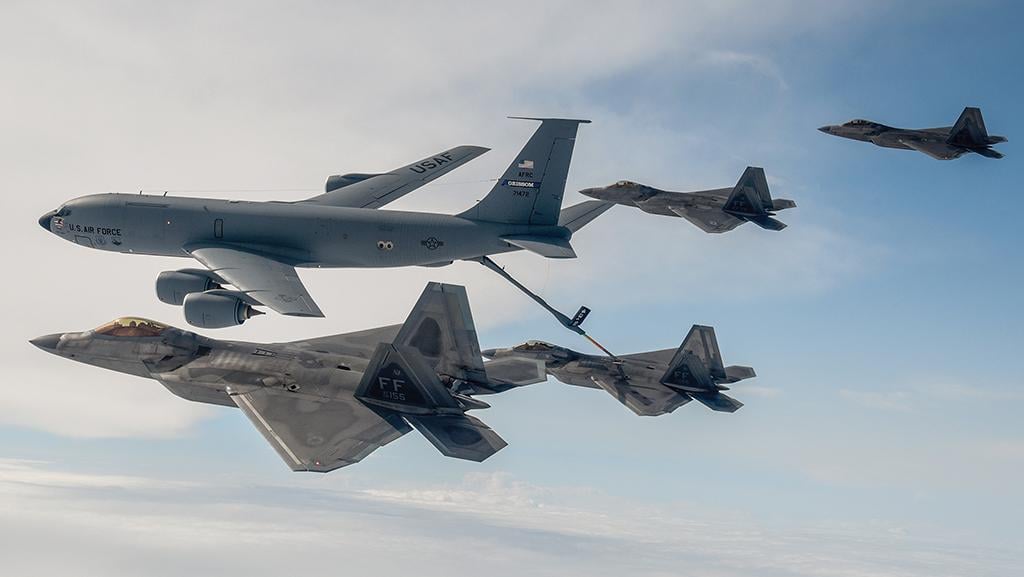This article is published in Aviation Week & Space Technology and is free to read until Sep 13, 2024. If you want to read more articles from this publication, please click the link to subscribe.

The Air Force is reconsidering plans for replacing F-22 fighters and KC-135 tankers.
The next generation of the U.S. Air Force has grown complicated over the span of several weeks, with top leaders indicating priority programs are being halted while others are accelerated.
Most notably, Air Force Secretary Frank Kendall says he has pressed pause on its Next-Generation Air Dominance (NGAD) platform for a few months as the service decides if the design it has worked on for years is the best plan.
It is the latest in an evolving saga for NGAD, following Kendall’s comments to Aviation Week in June that the service needs to reconsider how it performs the air dominance mission (AW&ST July 1-14). Speaking to a crowd of industry representatives at the Air Force Life Cycle Management Center’s Industry Days conference in Dayton, Ohio, Kendall provided the clearest statement yet on the NGAD status.
- The service’s secretary has confidence in the NGAD program despite its pause
- Tanker analysis is scheduled to finish this fall
“You may have heard about this, but with the platform itself, we’re taking a pause,” Kendall said July 30. “It’s at the time in any program where you really have your last chance to think very carefully if [you] really got the right design.”
The pause comes as the service was expected to award an engineering and manufacturing development contract for the platform, with presumed competitors Boeing and Lockheed Martin vying for the aircraft that would replace the Lockheed Martin F-22.
“We want to make sure we’ve got the right concept,” Kendall said. “We’re going to take a little bit of time to make sure you do before we make a major commitment. That’s the biggest commitment in any given development program, which is to start design and development for production. . . . I’m absolutely confident we’re still going to do a sixth-generation crewed aircraft.”
The original designs for the NGAD fighter, also known as the Penetrating Counter-Air platform, stemmed from studies Kendall commissioned in 2014 when he ran Pentagon acquisition. Since then, “the threat . . . has gotten much more severe,” he said.
The Air Force has said the NGAD platform would be part of a family of systems, notably including the uncrewed Collaborative Combat Aircraft (CCA). The service awarded contracts this year to Anduril and General Atomics Aeronautical Systems Inc. to develop the aircraft as part of the CCA program’s first increment.
Brig. Gen. Jason Voorheis, program executive officer for fighters and advanced aircraft at the Air Force Life Cycle Management Center, said July 29 that the service expects to bring both companies through to production. While a decision is anticipated in 2026, it is still a competition, meaning that the three other companies that did not receive the earlier award (Boeing, Lockheed Martin and Northrop Grumman) can still compete if they choose.
Officials also announced July 29 that the service had awarded contracts to five companies to develop the autonomy software that will be part of that increment. The companies’ names are classified, although they are said to be a mix of traditional and nontraditional businesses.
The service has been working toward the next increment and recently held an industry day to outline its schedule and early goals for that fleet. Industry officials have hinted that the next increment will focus on aircraft that are more capable and likely more expensive than those in the first round.
Additionally, Voorheis said this round will include more international support, including codevelopment and coproduction. For the first increment, the Air Force needed to move quickly, leaving no time for international involvement in the early stages. However, there could be Foreign Military Sales when the contractors move into production, he added.
An award for concept refinement for Increment 2 is expected in 2025. Kendall has said he is targeting a cost per unit of about $30 million, and Voorheis said his office expects to negotiate a better price.
For the propulsion side of the program, the Air Force is reaching out to industry to see what is available for the second increment. The air vehicle contracts for the first increment include the engine. The the Air Force Life Cycle Management Center’s Propulsion Directorate participated in the June industry day and is reviewing detailed prototype studies to inform the cost and schedule for engines that will power the increments, says John Sneden, the office’s director.
While the directorate last year released a request for information looking for engines in the 3,000-8,000-lb.-thrust class, the Air Force is not locked into that range. The engine needs will be informed by the overall requirements for the aircraft. There is a wide range of offerings in different thrust classes, Sneden says.
“Our focus is on the future,” he explains. “And everything that my organization is doing right now is looking at driving propulsion capability options for the long-term future of CCA.”
Following last year’s decision to cancel the Adaptive Engine Transition Program (AETP), work in Sneden’s directorate is now focused on the Next-Generation Adaptive Propulsion (NGAP) program. Sneden explains that NGAP is not directly tied to the shifting NGAD fighter.
“The program that we have today for NGAP is actually agnostic of any platform out there,” Sneden said July 29. “What we’re trying to do is create great propulsion options on the shelf for the warfighter.”
The directorate is scheduled to take the NGAP through design, prototype builds and testing. These prototypes will start to emerge in the next year and then continue into test “over the next handful of years.” he said.
At the same event two years ago, Sneden warned that AETP cancellation would be a significant hit to the country’s advanced engine development industrial base. Now he is sounding a similar warning about the NGAP. This time, however, the office is bolstered with some new funding under the last Pentagon appropriations bill specifically targeting advanced engine development.
“There’s a lot of if/thens that play into that,” Sneden says. “If we move entirely away from NGAP, we still have advanced engine development dollars to maintain our advanced propulsion industrial base to continue to refine those technologies. I don’t see that going away, necessarily, with an NGAP decision, but I will say the risk does concern me.”
Although Kendall has hit the brakes on the next-generation fighter, he appears willing to speed up a next-generation tanker program.
The Air Force expects to have completed an analysis of alternatives by October for the Next-Generation Aerial Refueling System (NGAS), a clean-sheet tanker designed to be more fortified than previous refuelers.
The analysis of alternatives will wrap in time for the service to make a decision for its fiscal 2026 budget, Kendall predicted. However, the Air Force could use its so-called Quick Start authority approved in the fiscal 2024 defense policy bill.
Under that authority, the Air Force can begin early design work through the preliminary design review ahead of full authorization and appropriations if the defense secretary deems it important for national security. The Air Force used its first round of Quick Start authority on efforts for space-based moving target indication. Each branch has a share of $100 million it can allocate to new acquisition programs.
Funding has been a question surrounding the NGAS since the program was announced, with so many programs already competing in the service’s budget. So far, the Air Force has committed only $8 million to the NGAS for the analysis of alternatives. Kevin Stamey, Air Force Life Cycle Management Center program executive officer for mobility and training aircraft, told reporters July 30 he has not been tasked with exploring Quick Start authorities for the NGAS. Kendall has told the directorate that the NGAS is a priority to be accelerated, and the authority could be an option.
The Air Force needs to make corporate decisions on where to go with both the NGAS and the nearer term replacement plan for its Boeing KC-135 tankers, Stamey said. The service had outlined its KC-135 Recapitalization Program for buying new tankers after the final procurement of the Boeing KC-46 in 2029. However, the Air Force has not yet committed to it.





